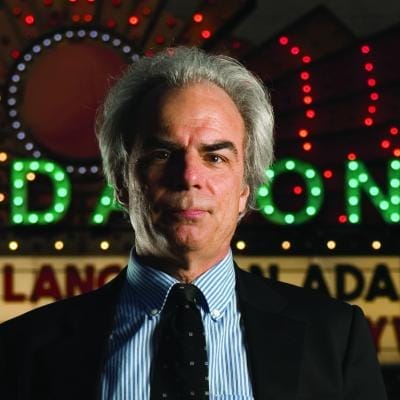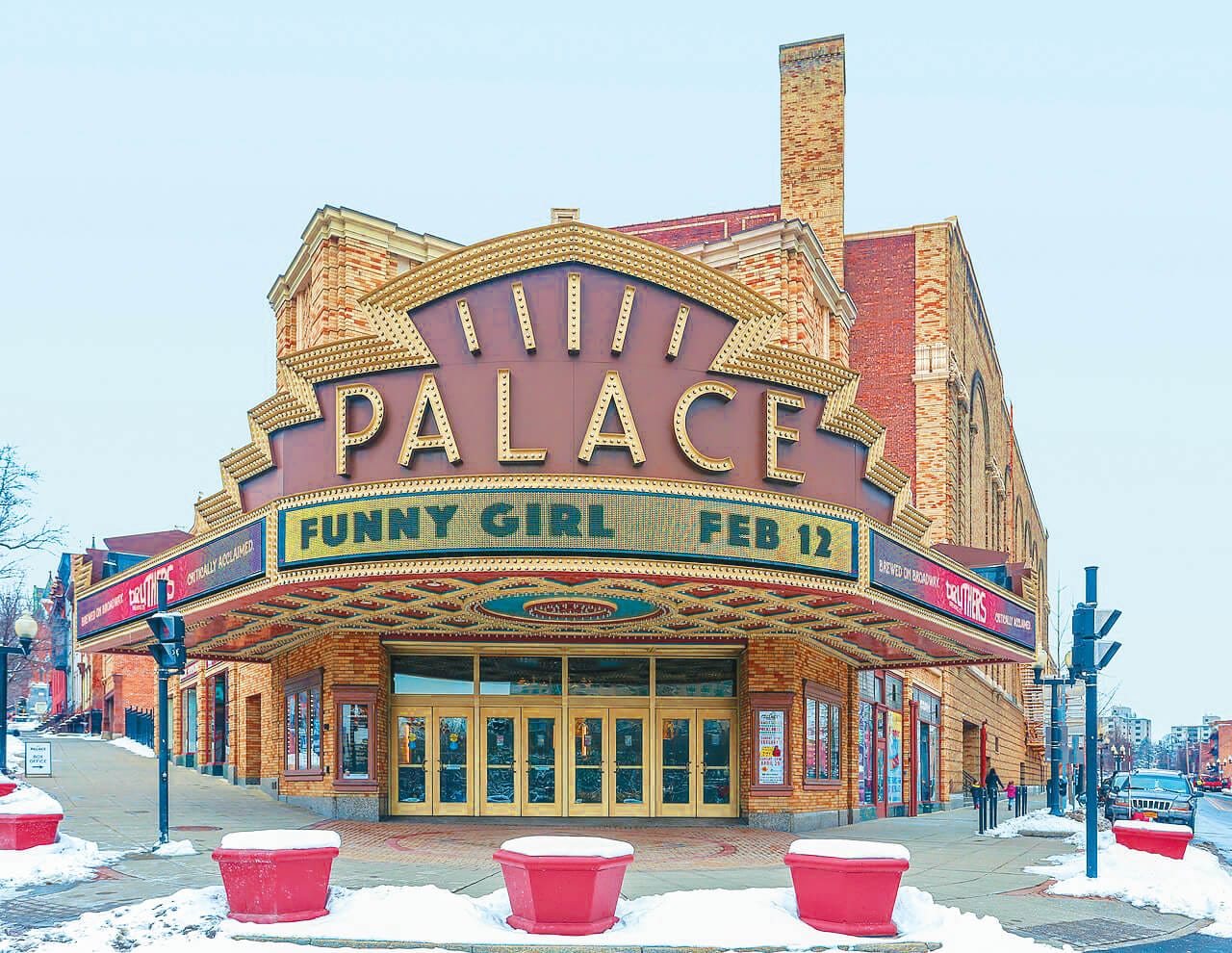Main Menu
Flyout Menu
Sinead O’Connor. Brandi Carlile. David Byrne (Talking Heads). Liza Minnelli. Bernadette Peters. Aretha Franklin. Arlo Guthrie. Anoushka Shankar.
These are just a few of the legendary performers I’ve seen grace the stage at the Bardavon 1869 Opera House on Market Street in Poughkeepsie, the Hudson Valley city located on the Hudson River shore halfway between Manhattan and Albany.
I met the late David Crosby of Crosby, Stills & Nash backstage at the Bardavon following his 2003 concert on the Ides of March. I met Bob Weir of Grateful Dead fame backstage before he performed at the Bardavon that October. I watched Carlos Santana electrify the 944-seat theater with searing guitar solos and a generous spirit in April 2016, days before he played Madison Square Garden. And Diana Ross—oh, Diana Ross—you left us all in such a state with your outpouring of love for Poughkeepsie in March 2011.
A former vaudeville house that has also hosted Mark Twain, Frank Sinatra and John Philip Sousa, the Bardavon is an anchor of the Hudson Valley. Beyond the performances, the décor, the warm welcome from the staff and the giddy buzz of show night, the Bardavon leaves a big footprint on its neighborhood. The venue spurs the local economy by drawing audiences that spend cash at neighboring businesses including, of course, restaurants and hotels; reminds us how the arts inspire critical thinking; and encourages individual creative expression.
And by way of similar theaters in similar communities across New York State—north and south and east and west—the impact of the arts maintains a firm foothold and remains embedded in the foundation of life in the Empire State.
There’s another aspect of these theaters that cannot be overlooked, one which the Bardavon illustrates in fine form. As these theaters bind communities together, Amtrak’s Empire Service and Adirondack rail lines bind historic theaters throughout New York State to each other—from community to community, and train station to train station.
Take, for example, the ease with which an Amtrak passenger can disembark at the Poughkeepsie Train Station. And then, said Bardavon Executive Director Chris Silva, “You can walk here from the train station.”
Silva also runs the Broadway Theater at Ulster Performing Arts Center in Kingston, a 1,500-seat venue on Broadway in New York State’s first capital. UPAC can be reached from the Amtrak station in Rhinecliff with a 20-minute ride in an Uber, Lyft or taxi. The Bardavon sits a five-minute ride from Amtrak in Poughkeepsie.

Each year, the Bardavon, which owns UPAC, attracts roughly 100,000 theater-goers to concerts and other events in Poughkeepsie and Kingston. Combined, the two theaters leave a more than $11 million impact on the economies of the two reenergized cities.
Both theaters also empower a sense of community, which is illustrated in sharp relief by community efforts that saved the Bardavon from being torn down after closing in 1975. Residents rallied. A half-dozen supporters mortgaged their homes to raise cash for the effort. Success was achieved, with the Bardavon reopening as a nonprofit organization in 1979.

The cultural destination has been dazzling theater-goers ever since.
“They cared enough to mortgage their homes to save the building,” Silva said of those supporters. “That’s community for you.”
Amtrak assumes an unlikely vantage point as it showcases the critical role that the arts play in the Empire State and how train travelers, with no fuss and no muss, can avail themselves of a compelling night out that resonates well beyond a performance’s final curtain. Surely, performers of generations ago rambled and rolled into these New York State train towns—from New York City to Buffalo—by way of the railroad. The theaters they performed in are open today. The train whistle beckons. It’s showtime and the moment is at hand to get your ticket punched by Amtrak.
Along with my passion for seeing live music in historic theaters—I’ve also seen shows at the Palace Theatre in Albany; Proctors Theatre in Schenectady; Landmark Theatre in Syracuse; and Stanley Theatre in Utica—I love, love, love boarding an Amtrak train and settling in for a journey that takes me as far away from the mundane predictability of driving a car as I can get. Poughkeepsie to Toronto on Amtrak anyone? I’ve done it twice and getting there was as much fun as being there.
Board an Amtrak train and you have no choice but to relax, unwind—and surrender. Amtrak demands you to catch your breath, take a beat and gaze at the world around you. All the while, there is a rumble beneath and possibilities out in front.
I’d be remiss if I did not confess to being seduced by the romance of the railroad. And, in a similar manner, I am mesmerized by stage lights, marquees and curtain calls. Why am I not surprised that I need only turn to Amtrak to indulge my passions for both.
From the Beacon Theatre and Radio City Music Hall in Manhattan to the Bardavon in Poughkeepsie, Landmark Theatre in Syracuse and Shea’s Performing Arts Center in Buffalo, Amtrak—forgive the pun—sets the stage for a night driven by arts, culture, history and, yes, the railroad.
Board a train. See a show.
Brianna Sprole, a 40-year old Syracuse resident, has been attending performances at the Landmark Theatre since she was in middle school. Concerts by Jackson Browne and The Moody Blues, as well as performances by national touring companies of smash Broadway musicals Hairspray, Mean Girls and Waitress are just a few of the shows Sprole has seen at the venue with the stunningly-ornate lobby, which could double as a movie set from Hollywood’s golden age of cinema.
And, oh yeah, Sprole was married at the 2,754-capacity Landmark—a five-minute drive from the Syracuse Amtrak stop. The ceremony was in an upstairs room. The cocktail hour was in the lobby, with dinner and dancing for 170 guests on the stage.
“I feel like it’s so cliché to say, but the Landmark is just magical,” said Sprole, who works virtually at The New School in Manhattan. “It’s such a stunning masterpiece of a building.
“The more the Landmark draws, the more shows they bring, the nicer that neighborhood is—you see stuff change; you can see the economic impact,” she said. “Syracuse wouldn’t be Syracuse without it. I think it’s an anchor, it’s a hub for the artistic center of Syracuse. It’s a hub of community life.”
“It’s cool to go to Broadway,” she said. “But this is your hometown. We have it here. We have the Landmark.”
That they do indeed.
NEW YORK CITY
1. Radio City Music Hall
2. Beacon Theatre
3. Madison Square Garden
POUGHKEEPSIE
4. Bardavon 1869 Opera House
ALBANY-RENSSELAER
5. Palace Theatre
6. MVP Arena
7. The Egg
8. Troy Savings Bank
Music Hall
SCHENECTADY
9. Proctors Theatre
10. Van Slyck’s at Rivers Casino & Resort
CROTON-ON-HUDSON
11. Paramount Hudson Valley Theater, Peekskill
UTICA
12. Stanley Theatre
SYRACUSE
13. Landmark Theatre
14. JMA Wireless Dome
ROCHESTER
15. Kodak Center
BUFFALO
16. Shea’s Performing Arts Center / Shea’s Smith Theatre
HUDSON
17. Hudson Hall at the historic Opera House
SARATOGA SPRINGS
18. Saratoga Performing Arts Center
19. Universal Preservation Hall
20. Caffe Lena
GLENS FALLS
21. Glens Falls Civic Center